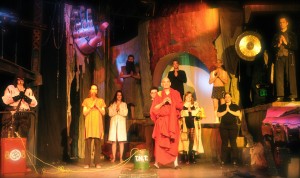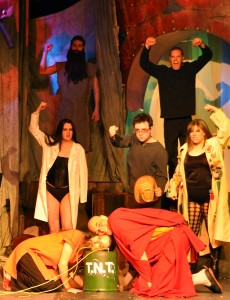Taking their bows, left to right: Jessamyn Geesaman, Marion H., Joni Pierce, Mike Thornwall, Willie LeJeune, Dan Hiester, Rick Bivens, Amy J. Lee, Josiah Lovato, Mariah Aguirre, Kenn Penn
This past sunday was the final performance of the Ten Buddhist Tales. The show was excellent, the audience reaction was excellent, and the spirits were high. I was transformed and elevated by the experience of assembling, leading, motivating and supporting a diverse team. What gives me the most pride however, is that I believe all of us came out of this with a feeling of personal success, and with some degree of personal growth.
We had set ourselves a tough target, a behemoth of a show: an enormous and complex set design, 27 scenes, 11 actors, 65 characters and costumes, over a hundred props, 80 sound and projection cues, all crammed into 90 minutes.
It worked. The show was a riotous explosion of visceral energy. It ran through the gamut of emotions, actions, thoughts and bodily functions. It jumped every few seconds, from thoughtful buddhist teachings, to extreme violence, to buffoonery, to heartfelt pleas of unconditional love. You can see some pictures of it in the DRD’s flickr stream.
Turning twelve tales into one story.
Rick, Kenn and I had written the twelve tales (there are three tales numbered “Part 7”) using the exquisite cadaver technique: Write a few lines, then pass the laptop to the next guy. The scripts were therefore an obscure tangle of streams of consciousness, from which we had to tease apart characters, motivation, context, and action. Then we had to pick twelve of them, put them in some kind of order, and somehow connect them. To that end, we lifted some select pieces of buddhist teaching from web sources and put them in the mouth of a character called Guru. We also expanded the originally minor character of the Bearded Lady, as a western counterpart to Guru.
It was a delicate balancing act, to provide a through-line and plot for the audience to hang on to while not watering down the innate randomness of the tales. I think we pulled it off, and the story arc ended up coming through strongly: The underlying tension quickly turns into chaos, out of which the insane characters and the Guru reach epiphanies, as the control-freak bearded lady loses her marbles.
At the beginning of each show, the Bearded Lady enters onto a pristine circle of white light to deliver a rather formal and scripted introduction. By the end of the show, the stage is a giant mess, covered in discarded props, costumes, spent shell casings, cantaloupe seeds, cake crumbs and candy. And on that disaster of a stage, the Bearded Lady in tears and the triumphantly radiant Guru are blown to bits with TNT.
Making meaning without making sense
And so it goes with life: Craziness will happen, randomness is in control, and you better have some real, deep foundation of mindfulness if you want to enjoy it well, and still face the inevitable end with a smile. This was one of the strongest points I wanted to express, that one needs an inner core of unconditional compassion and childlike openness, because the world makes no sense. The world is an illusion created by misunderstanding and misperception, and while it’s an illusion we cannot escape, we can, with mindfulness and concentrated effort, approach it like the beautiful drama that it is. Whether it be as an audience member, as an actor or behind the scenes, we can relish in the absurd experience we share, and in the joy of being together.
I think that point came through to some. The Buddhist audience members I talked to were very excited by the show, and appreciated that it wasn’t a farce based on the common misconceptions about Buddhism. I also had non-buddhists ask a lot of questions about the philosophical underpinnings of the play. All audience members were dazed and confused, but for those who didn’t leave the theatre mid-show, the confusion seems to have been fruitful.
I slowly came to understand what our friend the late great Don Becker meant when he said we were on to something with this play. He was talking about the fact that absurdist comedy is becoming mainstream, but also how the buddhist connection makes it work. I take it to mean that where absurdism is the end of western thought, the philosophical brick wall against which existentialists beat their heads, and come up with nothing but various shades of despair, cruelty, resignation, or at best stoicism. Yet absurdity, the realization that the world is an senseless illusion, is where eastern philosophy starts. And since it has no need to concern itself with useless concepts such as “reality”, it instead focuses, in a very practical and personal way, on happiness.
So to Don’s point, and as an answer to the enthusiasm of our buddhist audience members, I think we will keep the Ten Buddhist Tales alive. We did some extensive three-camera coverage on the last week of performances, and we will assemble and release the tales as a serial podcast, and promote it to the buddhist communities out there. Maybe this show, with its high aspirations,earnest pleas, and complete lack of self-control, can be an instrument of buddhist practice for others, as it was for us.
And if not, well, it’s pretty funny.

